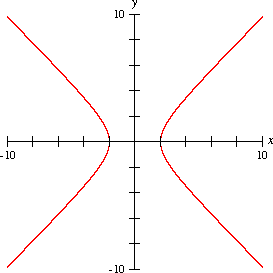Hyperbola
|
|
- For hyperbole, the figure of speech, see hyperbole.
In mathematics, a hyperbola is a type of conic section (literally: 'exaggeration' from the Greek word ’υπερβολή).
- Geometrically, it is defined as the intersection between a cone and a plane which cuts through both halves of the cone.
- Analytically, it is defined as the set of all points for which the difference in the distance to two fixed points (called the foci) is constant.
For a simple geometric proof that the two characterizations above are equivalent to each other, see Dandelin spheres.
| Contents |
Definitions
- It can also be defined as the locus of points for which the ratio of the distances to one focus and to a line (called the directrix) is a constant larger than 1. This constant is the eccentricity of the hyperbola. These foci lie on the transverse axis and their midpoint is called the center.
A hyperbola comprises two disconnected curves called its arms which separate the foci. At large distances from the foci the hyperbola begins to approximate two lines, known as asymptotes.
A hyperbola has the property that a ray originating at one of the foci is reflected in such a way as to appear to have originated at the other focus.
Drini-conjugatehyperbolas.png
A special case of the hyperbola is the equilateral or rectangular hyperbola, in which the asymptotes intersect at right angles. The rectangular hyperbola with the coordinate axes as its asymptotes is given by the equation xy=c, where c is a constant.
Just as the sine and cosine functions give a parametric equation for the ellipse, so the hyperbolic sine and hyperbolic cosine give a parametric equation for the hyperbola.
A body that has sufficient energy to escape the gravitational field of a massive body moves in a hyperbolic trajectory with the massive body at one of the foci.
If on the hyperbola equation one switches x and y, the conjugate hyperbola is obtained. An hyperbola and its conjugate have the same asymptotes.
Equations
Cartesian
(center (h, k) )
- <math>\frac{\left( x-h \right)^2}{a^2} - \frac{\left( y-k \right)^2}{b^2} = 1<math>
- <math>\frac{\left( y-k \right)^2}{a^2} - \frac{\left( x-h \right)^2}{b^2} = 1<math>
In both formulas a is called the semi-major axis; it is half the distance between the two branches; b is called the semi-minor axis. Note that b can be larger than a!
The eccentricity is given by
- <math>e = \sqrt{1+\frac{b^2}{a^2}}<math>
For rectangular hyperbolas with the coordinate axes parallel to their asymptotes:
- <math>(x-h)(y-k) = c \,<math>
Polar
- <math>r^2 =\ \ \, a\,\sec 2t<math>
- <math>r^2 = -a\,\sec 2t<math>
- <math>r^2 =\ \ \, a\,\csc 2t<math>
- <math>r^2 = -a\,\csc 2t<math>
Parametric
- <math>x = a\,\cosh \theta;\; y = b\,\sinh \theta<math>
- <math>x = a\,\tan \theta;\ \ y = b\,\sec \theta<math>
See also
- Ellipse
- parabola
- conic section
- Dandelin spheres
- hyperbole
- hyperbolic sector
- hyperbolic angle
- hyperbolic trajectory
- Inverted World (Book)
External links
- Template:Planetmath reference
- Template:Planetmath reference
- Template:Planetmath reference
- Mathworld - Hyperbola (http://mathworld.wolfram.com/Hyperbola.html)da:Hyperbel
de:Hyperbel_(Mathematik) eo:Hiperbolo es:Hipérbola fr:Hyperbole (mathématiques) it:Iperbole (geometria) ja:双曲線 nl:Hyperbool (meetkunde) pl:Hiperbola (matematyka) ru:Гипербола (математика) zh:双曲线

